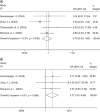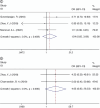Prognostic value of PD-L1 expression in patients with anal cancer: a meta-analysis
- PMID: 38700275
- PMCID: PMC11218801
- DOI: 10.2217/bmm-2023-0727
Prognostic value of PD-L1 expression in patients with anal cancer: a meta-analysis
Abstract
Background: The present meta-analysis was performed to evaluate the prognostic and clinicopathological significance of PD-L1 in anal cancer (AC). Methods: Hazard ratios (HRs) and 95% CIs regarding overall survival (OS) and progression-free survival (PFS) were calculated based on PD-L1 levels. Results: According to the combined data, PD-L1 showed no significant relationship with OS (HR = 0.76; 95% CI = 0.35-1.67; p = 0.502) or PFS (HR = 0.88; 95% CI = 0.35-2.33; p = 0.789) in patients with AC. Based on subgroup analysis, PD-L1 overexpression significantly predicted prolonged OS (HR = 0.38; 95% CI = 0.17-0.84; p = 0.017) in tumor node metastasis stages I-III and inferior PFS (HR = 2.73; 95% CI = 1.32-5.65; p = 0.007) in patients with stage I-IV AC. Conclusion: PD-L1 level assessed by immunohistochemistry did not significantly predict survival outcomes in AC cases.
Keywords: PD-L1; anal cancer; clinical practice • meta-analysis; prognosis.
Plain language summary
[Box: see text].
Conflict of interest statement
The authors have no competing interests or relevant affiliations with any organization or entity with the subject matter or materials discussed in the manuscript. This includes employment, consultancies, stock ownership or options and expert testimony.
Figures





Similar articles
-
The prognostic role of PD-L1 expression for survival in head and neck squamous cell carcinoma: A systematic review and meta-analysis.Oral Oncol. 2018 Nov;86:81-90. doi: 10.1016/j.oraloncology.2018.09.016. Epub 2018 Sep 17. Oral Oncol. 2018. PMID: 30409325
-
PD-L1 expression in anogenital and oropharyngeal squamous cell carcinomas associated with different clinicopathological features, HPV status and prognosis: a meta-analysis.Biosci Rep. 2021 Mar 26;41(3):BSR20203669. doi: 10.1042/BSR20203669. Biosci Rep. 2021. PMID: 33704390 Free PMC article.
-
Prognostic significance of programmed cell death-ligand 1 expression on circulating tumor cells in various cancers: A systematic review and meta-analysis.Cancer Med. 2021 Oct;10(20):7021-7039. doi: 10.1002/cam4.4236. Epub 2021 Aug 23. Cancer Med. 2021. PMID: 34423578 Free PMC article.
-
Prognostic significance of PD-L1 in solid tumor: An updated meta-analysis.Medicine (Baltimore). 2017 May;96(18):e6369. doi: 10.1097/MD.0000000000006369. Medicine (Baltimore). 2017. PMID: 28471952 Free PMC article. Review.
-
Association of Survival and Immune-Related Biomarkers With Immunotherapy in Patients With Non-Small Cell Lung Cancer: A Meta-analysis and Individual Patient-Level Analysis.JAMA Netw Open. 2019 Jul 3;2(7):e196879. doi: 10.1001/jamanetworkopen.2019.6879. JAMA Netw Open. 2019. PMID: 31290993 Free PMC article.
Cited by
-
Emerging advances and future opportunities in the molecular and therapeutic landscape of anal cancer.Nat Rev Clin Oncol. 2025 Jul;22(7):483-498. doi: 10.1038/s41571-025-01025-x. Epub 2025 May 13. Nat Rev Clin Oncol. 2025. PMID: 40360682 Review.
References
-
- Sung H, Ferlay J, Siegel RLet al. . Global Cancer Statistics 2020: GLOBOCAN estimates of incidence and mortality worldwide for 36 cancers in 185 countries. CA Cancer J. Clin. 71(3), 209–249 (2021). - PubMed
-
- Hoff PM, Coudry R, Moniz CM. Pathology of anal cancer. Surg. Oncol. Clin. North Am. 26(1), 57–71 (2017). - PubMed
-
- Daling JR, Madeleine MM, Johnson LGet al. . Human papillomavirus, smoking, and sexual practices in the etiology of anal cancer. Cancer 101(2), 270–280 (2004). - PubMed
-
- Giunta EF, Bregni G, Hendlisz A, Sclafani F. Anal squamous cell carcinoma: standards of care, new data and ongoing clinical trials. Curr. Opin. Oncol. 33(4), 372–377 (2021). - PubMed
Publication types
MeSH terms
Substances
LinkOut - more resources
Full Text Sources
Medical
Research Materials
